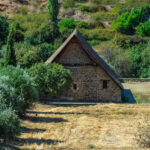The marriage of a fille du roi
It is unlikely that either Barthélémy Verreault or Marthe Quittel, my maternal ancestors, came to their marriage with an expectation of romance. Marriage was a state of life, a way of surviving, of producing children who could take care of you in your old age. So much the better if the proposed partner was attractive to you, but even better if he or she was strong and demonstrated abilities to survive under the most adverse of conditions.
The fille du roi visits her future home.
Did Marthe insist on visiting Barthélémy’s landholding in Chateau-Richer before agreeing to marry him? Accompanied by her chaperone as Barthélémy canoed up the river, did she remember the land she had first seen in July? Was she shocked at the sight of the house—there must have been one by late August—that she was to manage? Did she walk the farm and feel the soil, this city girl from Rouen? Did she calculate the advantages of a union with this man—the beneficial merging of material and character assets were after all the function of a marriage. Did Marthe talk to his neighbors—especially the women—to ask what sort of man Barthélémy was? Was he even-tempered and kind, did she ask the neighbors, Madame Cauchon and Barbe-Delphine Letardif? Would she be wiser to wait for another man? After all, filles du roi had a year to find a husband.
The answers were in Barthélémy’s favor because, some time during the month of August, Barthélémy and Marthe agreed to marry.
The fille du roi moves forward with marriage plans
On Monday, August 31, 1665, Barthélémy accompanied the notary Pierre Duquet (a Canada-born bachelor who would himself marry a fille du roi, Anne La Marre), to the house of Nicolas Marsolet to sign the marriage contract between him and Marthe. With the two men were Denis Derome, a fellow bourguignon [Burgundian] and fine tool maker, Jean Gervaise of Montréal (a baker who had come as part of la Grande Recrue [the 1653 recruit] and whom one can presume to be a friend of Barthélémy as both men had served in the Milice de la Sainte-Famille), and Etienne de Lessart[1] from Ste-Anne de Beaupré. De Lessart lived just downriver from Barthélémy and one can fancy that they met as the younger man was working on his property, getting it ready to receive a wife. The Marsolets stood in for Marthe’s parents, Denys Quittel and Louise Bénard.
The signing of the marriage contract of a fille du roi with a settler was a civil event that preceded the religious marriage. It constituted a formal agreement between the man and the woman, occupying some of the role of a modern engagement, and once entered upon, could only be broken with impunity with the consent of the two. Otherwise, the person wishing to annul the contract was to pay a penalty. The contract stipulated what each was bringing to the union. These would continue to be held separately so that, at the death of one spouse, the survivor would retrieve only what she or he had put into the union. There was also a stipulation for what each was putting into the “community of goods” that would be held jointly and that the survivor would inherit. Usually in the contract, there was a mention of the goods the bride brought in to the marriage with her dowry. As a fille du roi, Marthe would have brought a royal dowry with her but this particular marriage contract contained no mention of it. The contract bound the two together but did not permit a man and a woman to co-habit. For that, they would have to wait for the religious ceremony.
—
Here’s another posting on my 17th century ancestors.
This article is about how Marthe and Barthélémy meet. The fille du roi and the settler connect!
[1] A boatman who ran a 30-13-foot boat from Québec to Sainte-Anne de Beaupré or to Tadoussac, de Lessart had contributed the land on which stood the chapel to Ste Anne and, in 1662, he had inherited land in Québec city from his in-laws. The house was located on rue Notre Dame in the lower town. His home however was in Sainte-Anne de Beaupré where he farmed land on the Saint-Lawrence. On April 8, 1652, he had married Marguerite Sevestre. Serving as one of their witnesses was Monsieur de Lauson, governor of New France. Etienne de Lessart was the ancestor of my grandmother Yvonne Lessard who was to marry my grandfather Joseph Verreault in 1920.
This post is one of over 500 informative, well-written articles we have made available to you on this site.
We’ve contributed to your writing success; now we ask you to contribute to the expansion of the memoir conversation.
By reposting this article on your blog or website or reposting on your favorite social media, you will inform your fellow memoir writers of the programs and services—many for free like the blogs—that are available at TheMemoirNetwork.com.
Thanks for your generosity. You rock.


No comments yet.